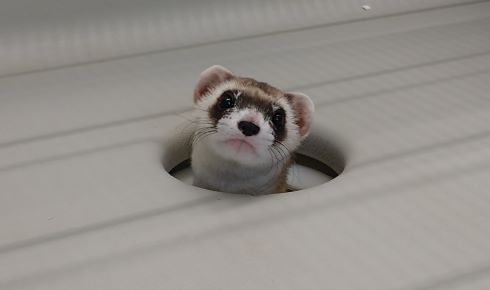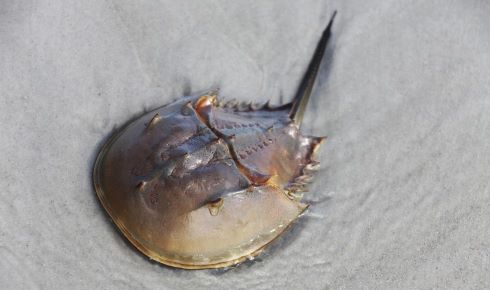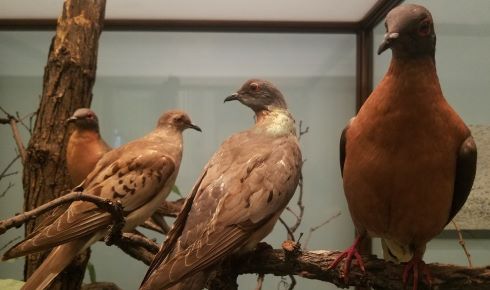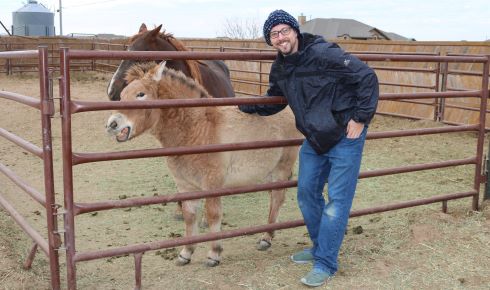Cloning for conservation

27th May 2024
Revive & Restore’s lead scientist Ben Novak on the organisation’s mission to use cutting-edge biotechnology to help save and ‘resurrect’ important species
Revive & Restore is a not-for-profit organisation promoting the development and adoption of biotechnologies in conservation. Founded by the American biomedical entrepreneur Ryan Phelan and her futurist husband, Stewart Brand, its work aims to protect and enhance biodiversity through the ‘genetic rescue’ of threatened, endangered and even extinct species.
Best known for controversial ‘de-extinction’ projects, Revive & Restore’s work has expanded to the development of a suite of technologies that could aid conservationists in their work, from genomics to gene editing to cloning. More recently it has moved into funding projects with similar aims.
Hi Ben. Can you give us an example of what your approach can achieve that ‘traditional’ conservation can’t?
The black-footed ferret is probably the first species in which we will be deploying the entire range of the toolkit we have been developing. When we were approached by the US Fish and Wildlife Service, it was clear there were two distinct threats facing this species that were compromising its long-term recovery.
The first is that the ferrets have become so rare that they have lost huge amounts of their original genetic diversity. The black-footed ferret was once found from southern Canada through central US to northern Mexico, but went down to a single surviving population of around 100 individuals. Despite the best efforts of captive breeding programmes, all the black-footed ferrets alive today are descended from just seven animals. They are all slightly more related to each other than first cousins, and the reproductive success of the species has been declining as a result.
The big news is that we cloned a black-footed ferret in 2020, with our partners Viagen, San Diego Zoo and the US Fish and Wildlife Service. It was cloned from cells in San Diego’s Frozen Zoo biobank from an animal that was unrelated to those original seven founders. That single individual has more unique alleles than virtually the entire surviving population.
There’s also an introduced disease, sylvatic plague, on the landscape, meaning no matter how successfully we can reintroduce genetic diversity, if an outbreak goes through, it just annihilates the population. There is a vaccine, but it’s so hard to vaccinate wild populations. So we are also looking at how we can get these ferrets to resist the disease. Through our partners at MIT, we’re working on turning the sylvatic plague vaccine used for the captive-bred ferrets into a gene, so that when individuals are released into the wild, they can then pass it on to their offspring.
We’re also looking at a range of lost alleles that we could potentially gene edit back into the population.
We can’t produce hundreds of clones to produce and spread these alleles – it’s very low efficiency for producing viable embryos and it takes a lot of resources. We’re also looking at whether stem cell technologies, such as in vitro gametogenesis or blastocyst complementation techniques, can help us get higher efficiency rates, so we can produce many more individuals.
For this species, it’s everything from using the genomic information, to the reproductive technologies, to biobank resources to gene editing, doing all of that to help overcome these issues with black-footed ferrets. And the issues facing the black-footed ferret are not unique – they are similar to what many other endangered species are facing.
 Elizabeth Ann, the first cloned black-footed ferret
Elizabeth Ann, the first cloned black-footed ferret
You mentioned the resources going into a project such as black-footed ferret cloning. Can you tell me what sort of costs have been involved with that project? And whether it is feasible to spend that amount of money on the many thousands of endangered species facing similar threats?
Before I go into that I’ll give you some context. Since 1967, when the black-footed ferret was listed as endangered, the US Federal Government has spent $1.99bn on its conservation. That is not including any money that was spent on land acquisitions to help the species. And that’s just the government money.
This work relies on partnerships with zoos and other non-profits. That’s a pretty typical number for the 1,600 or so endangered species in the US. There are species that have cost up to $4bn to conserve. Although they seem like huge numbers, they are cumulative figures over 40-plus years and annually the figure is fairly insignificant compared with total US government spending.
Our budget for the programme so far and for the next three years comes to about $2.5m. Yes, a couple of million dollars seems like a lot, but we’re trying to come up with solutions to stop us spending millions of dollars a year without a long-term solution.
In truth, we will probably end up having to roll out maybe 20-plus million dollars to achieve this through biotechnology. But our hope is you finally end up having a future where that species has real recovery.
Thinking of corals, too, it might take hundreds of millions of dollars to roll out biotech solutions for corals. But that’s a decades-long price for a centuries-long solution. Potentially a millennia-long solution.
Revive & Restore was founded with the bold aim to resurrect extinct species such as the passenger pigeon and woolly mammoth. Is it fair to say that the expansion of the range of activities and approaches that you’re developing was in response to feedback from the conservation sector about de-extinction? That such an objective wasn’t really a priority for them?
We certainly didn’t start with this expansive mission. Our founder Ryan Phelan came from the entrepreneurial and medical sectors, and had seen medical researchers really embracing all of these new technologies. So she hoped conservationists were too. And it turned out that they weren’t.
 Revive & Restore is working to end horseshoe crabs being harvested for their blood, which is used extensively in pharmaceutical testing
Revive & Restore is working to end horseshoe crabs being harvested for their blood, which is used extensively in pharmaceutical testing
When we started 12 years ago there were not very many conservationists using whole genome sequencing. There are still a lot of people today using microsatellites, single-gene PCRs – those are 30-plus-year-old technologies that only give you a sliver of information to combat all the pressures species are facing today.
It was felt that to push newer technologies into conservation, we should aim big. Do something really ambitious. Therefore, Revive & Restore was founded with a moonshot idea that, like the space race, might create all these peripheral technologies that are useful in the shorter term for conservationists.
It also became clear that there were many early adopters wanting to do things in this space but few funding sources willing to take these risks. Not only were we having trouble fundraising for what we were doing, but everyone else was having trouble getting funds. And so we started to think about whether we could get donors not just to invest in the projects that we think we need to spearhead, but to trust us to be the conduit to fund other people and help them succeed.
By 2018, we had finally succeeded in raising enough money to become our own funding organisation and we started putting out calls for proposals. And we went from being involved in about maybe six or seven projects to 70 projects in a matter of a few years. Most of which are conservation genomics projects: using whole genomes to inform translocations or captive breeding, and purposeful selection for resilience genes.
The project that always grabs the headlines when discussing biotech in conservation is the de-extinction of the woolly mammoth, which was originally a Revive & Restore project. Can you tell me a bit about why you handed that project off and why you still think it is of value?
That was a full hand-off when Colossal [co-founded by geneticist George Church and entrepreneur Ben Lamm] formed in 2021. We’ve had nothing to do with that project since then.
It’s worth noting that it was just a few days ago that they released their preprint on elephant’s stem cells, and that’s something that they’ve been trying to do for a decade. It was clear very early on that there were particular genes in Asian elephants that were acting as a barrier to creating stem cells.
This breakthrough is really great and it’s good to see that the mammoth project is making progress. If I am critical, I will say that the company makes a lot of claims about the first woolly mammoth being born in 2028. I don’t think they are going to hit their timelines.
We’re looking at the five to ten year range for gene-edited black-footed ferrets and having actual gene-editing organisms in nature. Because Asian elephants are endangered, Colossal is not using female individuals as surrogates, so they have a lot of innovative technology they need to create.
Also, it’s not going to be a woolly mammoth, is it? It will be an elephant with some mammoth genes.
It’s not genealogically a mammoth. It’s something that’s coming from the lineage of elephants but, ecologically, it will be a mammoth. The goal is to make an elephant that lives in Arctic ecosystems.
 Passenger pigeons are part of the organisation's flagship 'de-extinction' project
Passenger pigeons are part of the organisation's flagship 'de-extinction' project
Did you sense that this was not something conservationists want to do?
As you know, that topic meets with a lot of controversy among conservationists, with some being on board and others being quite sceptical and others being oddly against it for, sometimes, incredibly hypocritical reasons.
For example, there was a paper published recently by a critic of de-extinction that was applauding the umbrella concept of giant panda conservation, which to me is incredibly humorous, because when you evaluate giant panda conservation, by every metric that they’re criticising de-extinction it is equally bad or worse. Pandas are not ecologically significant; they’re not keystone species or top predators.
The paper was about how saving pandas makes people excited about conservation, and motivated to protect bamboo forests and those regions that help lots of other species in need. And that’s all the exact same concept of trying to recreate something extinct: to get people excited about where conservation can go, and to be able to help other species in an ecosystem.
Cloning for conservation
The birth of a cloned black-footed ferret in 2020 was part of a project aiming to increase the genetic diversity of the tiny remaining populations of the US’s only ferret species. The project is also looking at engineering lines of ferrets with disease resistance. Revive & Restore, alongside its partners, has also successfully cloned two Przewalski’s horses (Equus przewalskii).
Advanced Coral Toolkit
This project supports a range of technologies to help prevent coral loss, including cryopreservation, engineering disease resistance and resilience, and using stem cells to seed recovery.
Biotechnology for birds
Birds’ unique reproductive biology makes it difficult to use key technologies from mammals for genetic rescue, requiring the development of a new suite of technologies – including alternatives to cloning such as germ-line transmission.
Horseshoe crab blood
Revive & Restore is working to end horseshoe crab harvesting by advancing the adoption of synthetic alternatives to a compound found in their blood, LAL, which is used extensively in pharmaceutical testing.
Reviving extinct species
The organisation’s flagship ‘de-extinction’ project is focused on the passenger pigeon, an iconic and ecologically important American bird that once flocked in its millions before being hunted to extinction. Revive & Restore is also working on a project to revive the extinct wild heath hen.
Wild genomes
A funding programme to provide state-of-the-art genomic tools for field scientists, wildlife managers and citizens working to protect their local biodiversity.
I think another reason people are sceptical about this space is that very big claims are made through the media with few scientific data or publications available for peer-review or scrutiny. Do you publish peer-reviewed data on your projects?
Publication is not a first priority for us over making data available. So the concept of getting information up on preprints and genomic data on public databases is our first priority. We encourage all the teams we support to do that, but we also recognise that we’re funding university professors and researchers that need to have peer-reviewed publications to advance their careers and secure other sources of funding. Something we really wish we could push further on is the publication of null data and failures. But journals still don’t want to do that.
We just had a preprint published on our Przewalski’s horse cloning, and we have a paper ready to go on black-footed ferret cloning. But overall, we want the breakthroughs our teams make to be used in conservation. We don’t necessarily want them to spend six months trying to make a publication, when, within that same time, they could be getting that technology in the hands of someone in the field.
The reality of conservation genomics as a science is that for 30 years there have been thousands of great papers written that just sit on the shelves or in people’s hard drives, without translating to any application in nature. And that’s what we don’t want our work to do. We don’t want it to be interesting academic stuff that no one uses.
 Revive & Restore, with partners, has cloned Przewalski horses
Revive & Restore, with partners, has cloned Przewalski horses
Our last issue reported on the perilous status of many of the world’s plant and fungal species. Do you have any programmes focused on genetic rescue for plants and fungi?
Plants are something we haven’t worked with much yet. We only have three projects that have anything to do with plants out of the 70-something projects we’ve supported over the years, but we want that to change.
I think in previous decades, a lot of people kind of assumed that plant conservation was simpler than animal conservation and that plants were going to be okay. The other reality is it can be difficult to raise money for plants because people don’t emote with them in the same way they do with animals.
We would like to overcome all those barriers and develop more tools for plants. I’m hoping within the decade we can have as many plant projects as we have animal projects. And the threats to fungus are just starting to be appreciated, too.
Can your approach be applied to the ecosystem level as well as to individual species?
As a programme we have not focused on whole habitat levels yet. There are ways people have contemplated biotechnologies aiding entire ecological processes but I don’t think they are ready. There’s the use of environmental DNA or environmental RNA sequences for whole ecosystem monitoring – if you want to know that ecological restoration is working, if you were to switch to sequencing ecological RNA, you are monitoring what’s actually being expressed by the organisms’ genes. It’s also very short-lived in the environment, whereas DNA can last for years.
Right now we focus mainly on species because the reality, of course, is that an ecosystem is made of species and if we help one species the right way, that one species will have a benefit to the other species in an ecosystem in which it lives. We want to know that the application has significance at a bigger conservation level. And whether it could have an inspirational impact on conservation.
We do not have the levels of money that the larger international conservation organisations have. We’re not going to be able to pull together several hundred million dollars to roll out a biotech habitat restoration programme. But if we can catalyse several projects that show the clear value of what we’re doing, then maybe lots of other organisations will start adopting that and putting more money into it.
Where do you see the organisation moving in the future? Are there other technologies on the horizon that could allow you to do a greater range of things?
We have a stem cell programme in development. We hope to expand in that realm. Maybe by 2025 we’ll have more requests for proposals open and I think, in the long run, probably a decade-plus out, we’ll have our biotech for birds programme in operation.
I think that could launch into more reproductive technology innovation for things like reptiles and amphibians. The biotech toolkit for the lab mouse is the gold standard – what you can do with a lab mouse is astonishing. And so we will be rolling out programmes for particular taxonomic groups where there is a sense of urgency. The technological challenge will be big.
Ben Novak is lead scientist at Revive & Restore, an organisation using biotechnology to tackle conservation issues.


